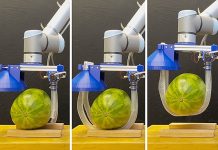
Engineers at Georgia Tech have built a soft robot that can jump as high as a basketball hoop—without using legs.
The 5-inch robot, made of soft silicone and reinforced with a carbon-fiber spine, was inspired by one of nature’s tiniest jumpers: a parasitic worm called a nematode.
Even though nematodes are thinner than a human hair, they can launch themselves into the air up to 20 times their body length.
That would be like a person lying down and somehow leaping onto the roof of a three-story building.
These worms use a clever trick to pull this off—they twist their bodies into tight shapes that store energy, then spring loose to jump.
By watching high-speed videos of nematodes, researchers noticed how the worms bend themselves differently depending on the direction they want to go.
To jump backward, they curve their head up and form a tight kink in the middle of their body.
To go forward, they reverse the shape. In both cases, they shift their body’s center of mass to aim and launch themselves, using stored energy like a coiled spring.
Although kinks usually signal trouble in things like straws, hoses, or blood vessels, these worms turn kinks into power.
Inspired by this, the engineers built computer models and then real-life soft robots that mimic this jumping style. The result: a flexible device that can leap up to 10 feet using the same principles.
Reinforced with carbon fiber, the robot stores a large amount of energy in its bent shape, then releases it in a split second—just one-tenth of a millisecond—to shoot into the air. And it’s tough enough to repeat this jump over and over again.
The research, published in Science Robotics, suggests that this kind of design could lead to new jumping robots that are simple, strong, and able to move across rough or unpredictable terrain. That could be useful in real-world missions like search and rescue or space exploration.
In fact, a jumping robot has already been sent to the moon, and more are being developed to handle environments that are too dangerous or difficult for humans.
The Georgia Tech team, led by Associate Professor Saad Bhamla and working with researchers from UC Berkeley and UC Riverside, continues to find ways that nature’s strangest creatures can inspire smarter robots.



